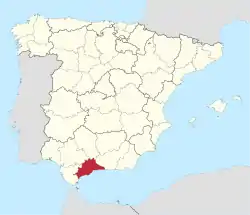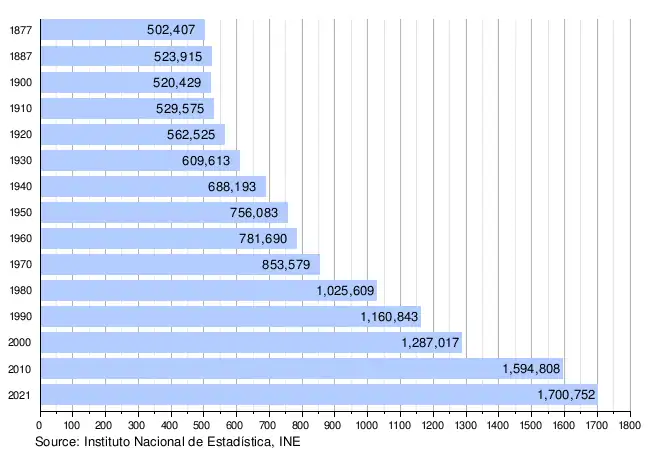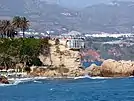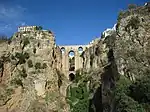Province of Málaga
The province of Málaga (Spanish: Provincia de Málaga [ˈmalaɣa]) is located in Andalusia, Spain. It is bordered by the Mediterranean Sea to the south and by the provinces of Cádiz to the west, Seville to the northwest, Córdoba to the north, and Granada to the east.
Province of Málaga
Provincia de Málaga | |
|---|---|
 Flag  Coat of arms | |
 Map of Spain with Málaga highlighted | |
| Coordinates: 36°43′N 4°25′W | |
| Country | Spain |
| Autonomous community | Andalusia |
| Capital | Málaga |
| Government | |
| • Body | Provincial Deputation of Málaga |
| • President | Francisco Salado (PP) |
| Area | |
| • Total | 7,308 km2 (2,822 sq mi) |
| • Rank | Ranked 35th |
| Population (2013) | |
| • Total | 1,652,999[1] |
| • Rank | Ranked 6th |
| Demonym(s) | Spanish: Malagueño, Malacitano |
| Official language(s) | Spanish |
| Parliament | Cortes Generales |
| Website | malaga.es |
| Click on the map for a fullscreen view | |
The province is subject to extreme water stress in the wake of the proliferation of avocado plantations in the Axarquía region, with the arid local climate being unsuitable to the plant's large water demands.[2]
Overview
Its area is 7,308 square kilometres (2,822 sq mi) and its population is 1,652,999 (2013), which is concentrated mainly in the metropolitan area of Málaga, province capital, and throughout the coastal area. The population density surpasses both the Andalusia and Spanish averages, reaching 222.53 inhabitants/km2. Málaga contains 102 municipalities. Besides the capital, its main cities are Marbella, Mijas, Fuengirola, Vélez-Málaga, Torremolinos, Estepona, and Benalmádena, all in the coastal zone. The towns of Antequera and Ronda are located in the interior.
The prevailing climate is a warm Mediterranean with dry and warm, long summers with short, mild winters. The geographical relief varies greatly from zone to zone. In general, the coastal zone has a subtropical Mediterranean climate. To the north, a continental Mediterranean climate exists with cold, dry winters and warm summers.
Its main industry and claim to fame is its tourist resorts, particularly those on the beaches along the Costa del Sol. These beaches are visited by millions of European tourists; other attractions include the gorge of El Chorro near Álora, El Torcal de Antequera, the Moorish-Mudéjar district of Frigiliana, the Dolmen of Menga, and the Caves of Nerja.
Population development
The historical population is given in the following chart:

Regions

Protected areas
See also
References
- Population Figures referring to Municipal Register 1 January 2013 Archived 6 October 2014 at the Wayback Machine - Instituto Nacional de Estadística
- Sánchez, Nacho (17 November 2020). "La provincia que produce más aguacates y mangos de Europa busca agua". El País.
_(cropped).jpg.webp)


2.jpg.webp)
.jpg.webp)

